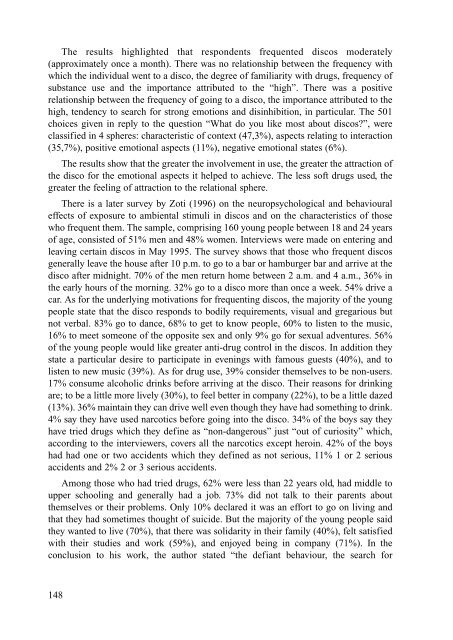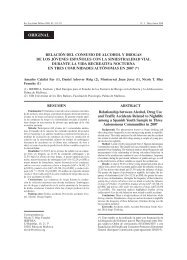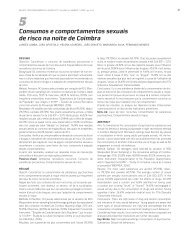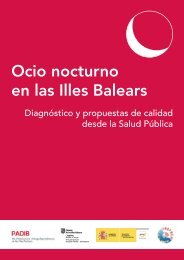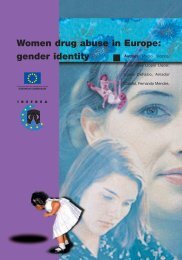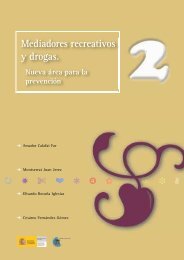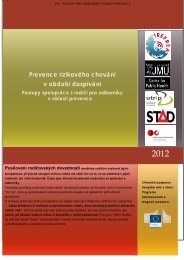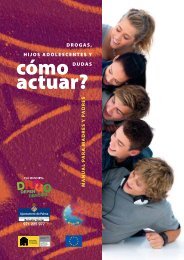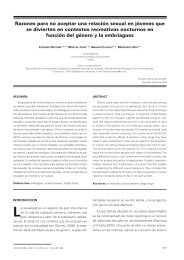Characteristics and social representation of ecstasy in Europe - Irefrea
Characteristics and social representation of ecstasy in Europe - Irefrea
Characteristics and social representation of ecstasy in Europe - Irefrea
Create successful ePaper yourself
Turn your PDF publications into a flip-book with our unique Google optimized e-Paper software.
The results highlighted that respondents frequented discos moderately(approximately once a month). There was no relationship between the frequency withwhich the <strong>in</strong>dividual went to a disco, the degree <strong>of</strong> familiarity with drugs, frequency <strong>of</strong>substance use <strong>and</strong> the importance attributed to the “high”. There was a positiverelationship between the frequency <strong>of</strong> go<strong>in</strong>g to a disco, the importance attributed to thehigh, tendency to search for strong emotions <strong>and</strong> dis<strong>in</strong>hibition, <strong>in</strong> particular. The 501choices given <strong>in</strong> reply to the question “What do you like most about discos?”, wereclassified <strong>in</strong> 4 spheres: characteristic <strong>of</strong> context (47,3%), aspects relat<strong>in</strong>g to <strong>in</strong>teraction(35,7%), positive emotional aspects (11%), negative emotional states (6%).The results show that the greater the <strong>in</strong>volvement <strong>in</strong> use, the greater the attraction <strong>of</strong>the disco for the emotional aspects it helped to achieve. The less s<strong>of</strong>t drugs used, thegreater the feel<strong>in</strong>g <strong>of</strong> attraction to the relational sphere.There is a later survey by Zoti (1996) on the neuropsychological <strong>and</strong> behaviouraleffects <strong>of</strong> exposure to ambiental stimuli <strong>in</strong> discos <strong>and</strong> on the characteristics <strong>of</strong> thosewho frequent them. The sample, compris<strong>in</strong>g 160 young people between 18 <strong>and</strong> 24 years<strong>of</strong> age, consisted <strong>of</strong> 51% men <strong>and</strong> 48% women. Interviews were made on enter<strong>in</strong>g <strong>and</strong>leav<strong>in</strong>g certa<strong>in</strong> discos <strong>in</strong> May 1995. The survey shows that those who frequent discosgenerally leave the house after 10 p.m. to go to a bar or hamburger bar <strong>and</strong> arrive at thedisco after midnight. 70% <strong>of</strong> the men return home between 2 a.m. <strong>and</strong> 4 a.m., 36% <strong>in</strong>the early hours <strong>of</strong> the morn<strong>in</strong>g. 32% go to a disco more than once a week. 54% drive acar. As for the underly<strong>in</strong>g motivations for frequent<strong>in</strong>g discos, the majority <strong>of</strong> the youngpeople state that the disco responds to bodily requirements, visual <strong>and</strong> gregarious butnot verbal. 83% go to dance, 68% to get to know people, 60% to listen to the music,16% to meet someone <strong>of</strong> the opposite sex <strong>and</strong> only 9% go for sexual adventures. 56%<strong>of</strong> the young people would like greater anti-drug control <strong>in</strong> the discos. In addition theystate a particular desire to participate <strong>in</strong> even<strong>in</strong>gs with famous guests (40%), <strong>and</strong> tolisten to new music (39%). As for drug use, 39% consider themselves to be non-users.17% consume alcoholic dr<strong>in</strong>ks before arriv<strong>in</strong>g at the disco. Their reasons for dr<strong>in</strong>k<strong>in</strong>gare; to be a little more lively (30%), to feel better <strong>in</strong> company (22%), to be a little dazed(13%). 36% ma<strong>in</strong>ta<strong>in</strong> they can drive well even though they have had someth<strong>in</strong>g to dr<strong>in</strong>k.4% say they have used narcotics before go<strong>in</strong>g <strong>in</strong>to the disco. 34% <strong>of</strong> the boys say theyhave tried drugs which they def<strong>in</strong>e as “non-dangerous” just “out <strong>of</strong> curiosity” which,accord<strong>in</strong>g to the <strong>in</strong>terviewers, covers all the narcotics except hero<strong>in</strong>. 42% <strong>of</strong> the boyshad had one or two accidents which they def<strong>in</strong>ed as not serious, 11% 1 or 2 seriousaccidents <strong>and</strong> 2% 2 or 3 serious accidents.Among those who had tried drugs, 62% were less than 22 years old, had middle toupper school<strong>in</strong>g <strong>and</strong> generally had a job. 73% did not talk to their parents aboutthemselves or their problems. Only 10% declared it was an effort to go on liv<strong>in</strong>g <strong>and</strong>that they had sometimes thought <strong>of</strong> suicide. But the majority <strong>of</strong> the young people saidthey wanted to live (70%), that there was solidarity <strong>in</strong> their family (40%), felt satisfiedwith their studies <strong>and</strong> work (59%), <strong>and</strong> enjoyed be<strong>in</strong>g <strong>in</strong> company (71%). In theconclusion to his work, the author stated “the defiant behaviour, the search for148


